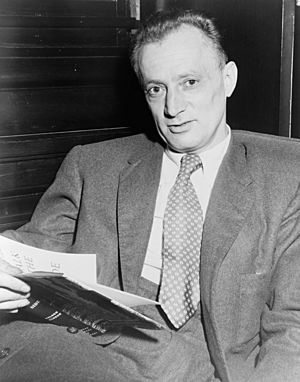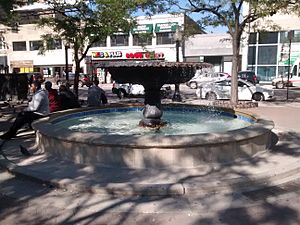Nelson Algren facts for kids
Quick facts for kids
Nelson Algren
|
|
|---|---|

Algren in 1956
|
|
| Born | Nelson Ahlgren Abraham March 28, 1909 Detroit, Michigan, U.S. |
| Died | May 9, 1981 (aged 72) Long Island, New York, U.S. |
| Occupation | Writer |
| Alma mater | University of Illinois, Urbana–Champaign (BA) |
| Genre | Novel, short story |
| Notable awards | National Book Award 1950 |
| Spouse |
|
| Partner | Simone de Beauvoir (1947–1964) |
Nelson Algren (born Nelson Ahlgren Abraham; March 28, 1909 – May 9, 1981) was an American writer. He was known for writing about people living on the edges of society, often in his beloved city of Chicago. His 1949 novel The Man with the Golden Arm won a major award called the National Book Award. This book was later made into a popular movie in 1955.
Algren was seen as one of America's most famous writers in the late 1940s and early 1950s. He was a close friend and partner of the French writer Simone de Beauvoir. She even wrote about him in her novel The Mandarins. People called Algren "a sort of bard of the down-and-outer" because he wrote so well about those who faced tough times. His short stories in The Neon Wilderness (1947) and his novel A Walk on the Wild Side (1956) also showed this special talent.
Contents
Nelson Algren's Early Life
Nelson Algren was born in Detroit, Michigan. When he was three years old, his family moved to Chicago, Illinois. They lived in a busy, working-class neighborhood on the South Side. His father had Swedish and German Jewish roots, and his mother was of German Jewish descent. His mother even owned a candy store!
When Nelson was eight, his family moved to the North Side of Chicago. His father worked as an auto mechanic nearby. In his essay Chicago: City on the Make, Algren shared that he was teased as a child for being a fan of the South Side White Sox baseball team, even after moving to the North Side. He remained a White Sox fan his whole life.
Algren went to public schools in Chicago and graduated from Hibbard High School. He then studied journalism at the University of Illinois at Urbana–Champaign, graduating in 1931 during the Great Depression. While in college, he wrote for the student newspaper, Daily Illini.
Becoming a Writer
Algren wrote his first story, "So Help Me," in 1933. At the time, he was working at a gas station in Texas. Before returning to Chicago, he faced a difficult situation that deeply affected him. This experience made him feel a strong connection to people who were struggling or felt like outsiders. These types of characters later filled his books.
In 1935, Algren won his first O. Henry Awards for his short story, "The Brother's House." This story was first printed in Story magazine.
His first novel, Somebody in Boots (1935), was not very successful. Algren later felt it was too simple. He married Amanda Kontowicz in 1937, but they would divorce and remarry before divorcing a final time.
His Second Novel
Algren's second novel, Never Come Morning (1942), was praised by famous writer Ernest Hemingway. Hemingway called it "very, very good." The book told the story of a young Polish-American boxer facing a tough life. However, some members of Chicago's large Polish-American community were offended by the book. They felt it showed their community in a negative way. They even convinced Mayor Edward Joseph Kelly to have the novel removed from the Chicago Public Library.
Serving in World War II
Algren served as a private in the European Theater during World War II. He was a litter bearer, which meant he helped carry injured soldiers. Even though he had a college degree, he was not allowed to become an officer. This might have been because of his past difficulties or his political views.
Algren was drafted into the army in 1943. He wasn't very interested in military life. While stationed in France, he sometimes traded goods informally, which led to him getting into trouble.
Nelson Algren's Fame and Success

Algren's first collection of short stories, The Neon Wilderness (1947), brought together 24 of his works. In the same year, he received an award from the American Academy of Arts and Letters.
His next novel, The Man With the Golden Arm (1949), became his most famous book. It won the National Book Award for Fiction in 1950. The main character, Frankie Machine, is a drummer who faces many challenges in his life.
Algren's book Chicago, City on the Make (1951) was an essay that described the city's hidden corners, its struggling people, and its problems. While some city leaders were upset by it, Algren also showed his deep love for Chicago.
The Man With the Golden Arm Film
The Man With the Golden Arm was made into a movie in 1955 starring Frank Sinatra. Algren was not happy with the film, even though it was a big success. He felt it didn't truly capture the spirit of his book.
In 1955, Algren was interviewed by author Terry Southern for The Paris Review. They became good friends, and Algren often praised Southern's writing.
Algren had another successful novel with A Walk on the Wild Side (1956). He used some ideas from his first novel and other short stories for this book. It was about a young man wandering during the early years of the Great Depression. This book was also made into a movie in 1962.
Later Life and Legacy
After A Walk on the Wild Side, Algren's books were not as commercially successful. He started teaching creative writing at the University of Iowa's Writers Workshop to earn money.
In 1965, he married Betty Ann Jones, but they divorced in 1967. Another writer, Kurt Vonnegut, who taught with Algren, said that Algren's love for writing, reading, and gambling left little time for married life.
In 1975, Algren was asked to write about the trial of Rubin "Hurricane" Carter, a boxer accused of murder. While researching, Algren became fascinated by Paterson, New Jersey, and decided to move there from Chicago.
In 1980, Algren moved to Sag Harbor, Long Island. He passed away from a heart attack on May 9, 1981, and is buried in Oakland Cemetery.
Books Published After His Death
After Nelson Algren died, a novel he had been working on about Rubin "Hurricane" Carter was found. It was published in 1983 as The Devil's Stocking.
In 1996, a book called Nonconformity was published. It shared Algren's thoughts on the challenges of making The Man With the Golden Arm into a film. It also explained his writing beliefs and encouraged writers to explore difficult topics and represent overlooked people.
Algren and Chicago's Polish Community
Algren had a strong connection to Chicago's Polish community. His first wife, Amanda Kontowicz, was Polish-American. He often spent time in Polish bars, which appeared in his books like Never Come Morning and The Man With the Golden Arm.
However, his novel Never Come Morning caused controversy within the Polish-American community. They felt it used negative stereotypes. The book was even removed from the Chicago Public Library for many years.
Later, there were efforts to honor Algren in Chicago, including renaming a street and a fountain. These efforts sometimes faced challenges because of the past controversy. In the end, a fountain in the Polish Triangle was named after him. It has a quote from his essay Chicago: City on the Make about the city's working people.
Awards and Recognition
Nelson Algren won several awards for his writing:
- He won his first O. Henry Award in 1935 for his short story "The Brother's House." He won two more O. Henry Awards in 1941 and 1950 for other short stories.
- The Man With the Golden Arm won the National Book Award for Fiction in 1950.
- In 1947, he received an Arts and Letters Award. In 1974, he was given the Award of Merit Medal for his novels. Just before he died in 1981, he was elected to the Academy of Arts and Letters.
- In 1998, the Nelson Algren Fountain was dedicated in Chicago's Polonia Triangle, a place that inspired much of his work.
- In 2010, Algren was honored by being added to the Chicago Literary Hall of Fame.
Nelson Algren Award
Each year, the Chicago Tribune newspaper gives out a Nelson Algren award for short stories. Winners are published in the newspaper and receive $5,000. This award is a bit ironic because the Tribune newspaper often criticized Algren's work during his lifetime.
In 1989, a group called the Nelson Algren Committee was started by writer Studs Terkel and others. This happened when people became interested in Algren's work again. The Committee gives an annual award to community activists and holds a birthday party for Algren. All of Nelson Algren's books are now available to read.
Images for kids
See also
 In Spanish: Nelson Algren para niños
In Spanish: Nelson Algren para niños





